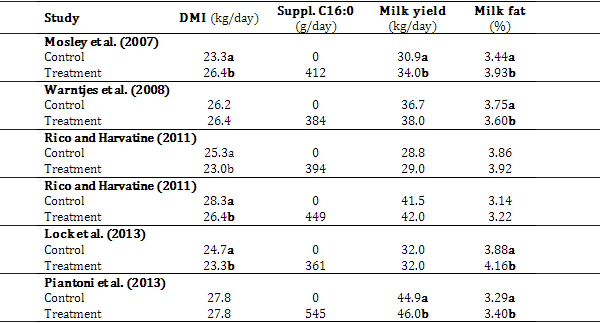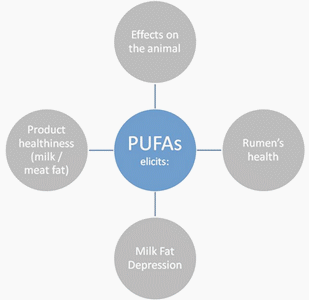Functionality:Behind fatty acids, specific functions remain
In the recent years, we have observed a great torrent of new knowledge regarding fatty acids functions and role in improving products’ quality. Therefore, nutritionists are already formulating taking into account both quantities and proportions of different fatty acids.
Productivity & Profitability: C16:0, trending topic in academy and field
C16:0 has been one of the first fatty acids to be individually considered in formulation, in order to increase milk fat %.
Palmitic acid (C16:0) has become recurrent in nutritionist conversations, as it has been proposed (and showed to be) as an effective tool to increase milk fat percent, and much of research has been carried out on this during the last years (see some examples in table 1).
Table 1. Brief review of recent studies addressing C16:0 effects on milk production

Source: Adapted from Loften et al. (2014)
Products’ healthiness for human consumption: PUFAs (Omega)
Furthermore, essential fatty acids are being considered in fatty acids formulation due to their specific roles in cows' reproduction outcomes, immunity, inflammation regulation and also in product quality.
From consumers’ behavior point of view, there is a growing demand toward healthier foods, such as PUFAs-enriched meat and dairy products. Among them, Omega-3 enriched products are star products on supermarkets’ shelves and television ads, as they have been claimed to have positive effects on both cardiovascular and neurological health, as well as on immunity and inflammation regulation.
Consequently, the presence of these fatty acids in meat and dairy products is gaining interest day by day also for farms and the industry and allows manufacturing premium products of higher profitability.
From the nutritionists’ point of view, PUFAs topic is more complex, as these fatty acids must be rumen-protected (unlike direct effect on rumen –i.e. CH4 abatement). Thus, when technical people hear ‘PUFAs’, we think almost automatically about their externalities and the following dynamic interactions (figure 1).
 Figure 1:
Figure 1: Elicited ideas by ‘PUFAs’ term / concept
Efficiency & Sustainability:Enteric CH4abatement
The ability of ruminants to turn fibre-rich, human-inedible products into human-edible food is of large significance in terms of global food security. As human populations increase and available arable land decreases, agricultural systems are under pressure to produce more food more efficiently (Dijkstra, 2013).
However, fiber utilization increases CH4 production in rumen, which is important in the overall contribution of the livestock sector to Global Warming (figure 2). Enteric fermentation accounts for the 11% of global methane production. Cattle, followed by dairy cows, are the major CH4 ‘producers’ within the livestock sector.
 Figure 2.
Figure 2. Livestock contribution to GHGs emissions (source: The GLEAM 1.0)
Moreover, CH4 means a reduction in feed efficiency. CH4 emissions usually represent a loss of some 4 to 8% of dietary energy. Various potentially effective CH4 mitigation practices are available for the ruminants sector. Among them, PUFAs are one of the most powerful tools.
According to the review carried out by Rasmussen & Harison (211), the addition of supplementary fat to the diet of ruminants has been reported to effectively reduce methane production. Primarily it is the medium chain (laurin and myristic acids) and polyunsaturated (linoleic and especially linolenic) fatty acids that appear to be most efficacious.
Conclusions / Summary
Fatty acids are nowadays going through a conceptual revolution due to the recent torrent of scientific knowledge, re-positioning them as functional components of the diets with diverse implications (from the animal, environmental and human health perspectives).
The chemical form in which they are provided to the animals makes them to have different sites of action and externalities, making this even more complex in ruminants production.
Coming years will bring interesting results that will have great consequences and allow us to have a deeper understanding of fatty acids functions and how to balance the elicited ideas and implications surrounding PUFAs for ruminants’ nutrition. Farm trials using commercial products with different rumen-protection technologies and under different conditions (heat-stressed, lower pH, different passage rate diets, etc.) will be necessary to continue increasing efficiency in this wave of precise nutrition.
Note: Article originally published in Milling and Grain, September 2017, pp.72-74















